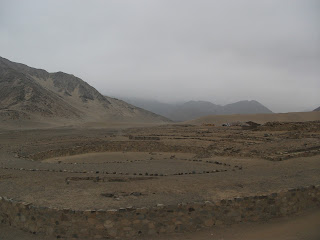Caral was the place where it
all started, just a few hours north of Lima,
Peru.
I don’t refer to an
incident, or even a long, dramatic series of events. By “it all,” I am referring to everything.
The ruins at Caral are the
oldest signs of civilization in the western hemisphere. They were built at the same time as the
pyramids of Egypt, and are
only 200 years more recent than the oldest of the old in Mesopotamia.
The type of structures they
built? Pyramids…hmmm.
We decided to pile into a
bus, and ride the three hours along the coastal highway to visit this pile of
stones in the middle of nowhere. The
ride itself was a spectacular visual journey.
As we traveled outside of Lima,
every strata of society displayed its living arrangement.
Once clear of the suburbs, the
Pan American Highway
treated us to alternating views of rugged coastline, and giant valleys filled
with small fields of corn, strawberries, or fresh flowers. The ride itself is a great part of the trip. The final half hour was a low speed journey
through the valley
of Caral, and across a
dry riverbed that made us question the agility of the tour bus.
We arrived at the ruins at
midday (Middle and Youngest called them “big piles of rocks and dirt”). Fortunately, the sun was still behind clouds
as it is in most of the winter. The old
city itself consisted of about a half dozen larger pyramids, maybe four or five
stories tall, and a few smaller structures. Some housed large burn pits, essentially giant
stone furnaces, used for cooking and sacrificing stuff to the gods of barbecue.
The reasons mankind sought
to live clustered together is still a subject of some argument. As hunter-gatherers, more people means more
mouths to feed. Until food could be
stored, anything beyond immediate family just needs to go find their own food.
Except there is no evidence
of pottery at Caral.
Another theory is that
people got tired of hunting and gathering, and decided that they could form
roaming bands and clunk other people over the head and take their food, so thus
people began clustering together to defend themselves against warring factions.
Except there is no evidence
of weapons at Caral, either.
As it turns out, the current
theory is that someone figured out they could weave fishing nets out of cotton,
which grew too far from the ocean to be of any use, but if the nets were
carried to the ocean, they could be traded for fish. Since Caral is a day’s walk from either
resource, it looks like it started as a trading post. It’s built on the very border of the coastal
desert, on a patch of ground that looks like it has never seen a blade of grass,
which made sense as agriculture developed in the valley.
For those seeking a tourist
experience in Peru, the
Caral day-trip isn’t at all like the jungles of the Amazon, or the mountains of
Machu Picchu. It’s
more relaxed and reflective, as you imagine people living and working there, who have been
gone for five millennia. For reasons
that were revolutionary at the time, people decided that living together was
better than roaming the world alone.
It isn’t nearly as
interesting as the theory I had. I
always thought civilization sprang forth due to the discovery of beer.


No comments:
Post a Comment